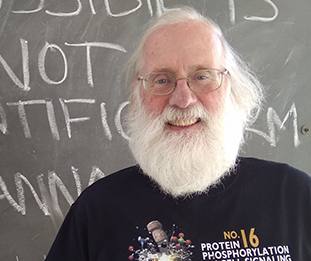Tyrosine kinase inhibitors (TKIs) are the prototypes of targeted therapies, which already have significant impacts on the treatment of cancer patients. Dr. Tony Hunter, Professor of Biology at the Salk Institute, gave birth to this field by discovering tyrosine phosphorylation and that the oncogene src is a tyrosine kinase. At that time, it was already known that kinases are enzymes that can attach phosphates on the amino acids serine and threonine of a protein, but the discovery that tyrosine could also be phosphorylated revealed a brand new level of cellular regulation critically involved in development and disease. In the human genome, the tyrosine kinase family represents a minor class of protein kinases, but they are a major family of oncogenes (cancer-inducing genes). This is because many of them are receptors on the cell surface and are critically involved in transmitting signals to instruct cells to grow in response to environmental cues such as growth factors. Upon mutations, they become constitutively active and no longer require environmental cues to trigger a response. Cells would then grow incessantly, eventually becoming malignant.
As demonstrated later, shutting off the oncogenic tyrosine kinase signals by small molecules or antibodies indeed stops cancer cell growth and is an effective way to treat cancers. Mutated or activated tyrosine kinases have become superb diagnosis and prognosis markers for cancer. In addition to growth, tyrosine kinases are now found to function in cell migration, survival and other malignant phenotypes. Dr. Hunter’s discovery in 1979 at the Salk Institute paved the road for the next twenty years’ active research on tyrosine kinase oncogenes, leading to the development of TKIs (tyrosine kinase inhibitors). The field is still going strong almost forty years after his discovery. He also showed that cancer cells are highly tyrosyl-phosphorylated, and with his colleague, Bart Sefton, developed anti-phosphotyrosine antibodies, a very powerful tool for studying cancer signals and identifying TKIs. Thus, it is no exaggeration to say Dr. Tony Hunter opened up the “tyrosine kinase field” and brought forth the golden era of signal transduction research. The current success of targeted therapy owes a great deal to him.
Dr. Brian Druker, Director of Oregon Health Sciences University Knight Cancer Institute, is the physician scientist who led the successful clinical trial of imatinib (Gleevec®) on chronic myelogenous leukemia (CML), which opened up the field of TKI as targeted therapy. Gleevec shuts off oncogenic signals by inhibiting Abl tyrosine kinase (translocated as Bcr-Abl oncogene in CML), as predicted by Tony Hunter’s original hypothesis. Abl is a tyrosine kinase, the gene of which upon translocation to a different chromosomal site (Bcr [breakpoint cluster region]) becomes constitutively active. In addition to Abl, Gleevec also inhibits Kit, PDGF and other tyrosine kinase oncoproteins. It has been useful in the treatment of acute lymphocytic leukemia (ALL) and certain types of gastrointestinal stromal tumors (GISTs) where Kit is overexpressed. Now there are more than 29 TKIs which have been approved for clinical use. Clearly, Dr. Druker’s first successful trials heralded this still burgeoning targeted therapy era. Dr. Druker was also involved in the development of the 4G10 antibody (at Thomas Robert’s lab) which recognizes phosphotyrosine and was used by Novartis colleagues in the screening of Gleevec. Thus, Dr. Druker’s contributions are in both the development and application of Gleevec, which was the first successful example of tyrosine kinase-targeted therapy by small molecule inhibitors.
Dr. John Mendelsohn, President Emeritus of MD Anderson Cancer Center, took another approach while at UC San Diego working with Dr. Gordon Sato. An alternative way of shutting off the activities of tyrosine kinases on the cell surface (receptor tyrosine kinase) is to develop antibodies against the extracellular domain of the receptor. In such a way, the natural ligand (e.g., growth factor) can no longer bind, thus the receptor tyrosine kinase is no longer activated. They conceived the idea that antibodies targeting epidermal growth factor receptor (EGFR) may be an effective strategy for cancer treatment. EGFR is the prototype of receptor tyrosine kinases, located on the cell surface and a main engine to drive cell growth. It is often overexpressed or mutated to become oncogenic in different types of cancer. Dr. Mendelsohn and his team conducted preclinical research and proceeded to develop the anti-EGFR antibody cetuximab (Erbitux®). His effort to promote it into clinics eventually won the approval of the US FDA for the treatment of colon cancer and head/neck cancer. This was the first clinically approved therapy using an antibody to inhibit the tyrosine kinase of a growth factor receptor and a trail-blazer which has spurred many others to follow.
In summary, the discovery of protein tyrosine phosphorylation and tyrosine kinases sowed the seed for research in the ensuing forty years leading to a thorough understanding of the fundamental principles of cell growth and cancer development. The development of tyrosine kinase-targeted therapies has fundamentally changed the practices of cancer clinics. It provides great benefits to patients who suffer from this dreadful disease and gives hope that cancer can eventually be treated. The contributions of this years’ Tang Prize in Biopharmaceutical Science awardees to science and society are immeasurable. Their accomplishments amply illustrate how brilliant basic science can lead to clinical applications that benefit all mankind.

/BS/PhotoCap_%E8%8B%B1%E6%96%87_%E7%94%9F%E9%86%AB-01.jpg?1659423355283)
/BS/PhotoCap_%E8%8B%B1%E6%96%87_%E7%94%9F%E9%86%AB-02.jpg?1659423360715)
/BS/PhotoCap_%E8%8B%B1%E6%96%87_%E7%94%9F%E9%86%AB-03.jpg?1659423365475)
/BS/PhotoCap_%E8%8B%B1%E6%96%87_%E7%94%9F%E9%86%AB-04.jpg?1659423369547)
/BS/PhotoCap_%E8%8B%B1%E6%96%87_%E7%94%9F%E9%86%AB-05.jpg?1659423374131)
